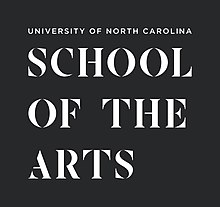UNC School of the Arts
 |
|
|
Former names
|
North Carolina School of the Arts (1963-2008) |
|---|---|
| Type | Public |
| Established | 1963 |
| Endowment | $27.7 million |
| Chancellor | M. Lindsay Bierman |
|
Academic staff
|
186 |
| Students | 1,144 |
| Undergraduates | 739 |
| Postgraduates | 124 |
|
Other students
|
276 (high school) 5 (special) |
| Location | Winston-Salem, North Carolina, United States |
| Campus | Urban |
| Colors |
UNCSA Black |
| Affiliations | University of North Carolina |
| Website | www.uncsa.edu |
 |
|
UNCSA Black
The University of North Carolina School of the Arts (UNCSA) is a public coeducational arts conservatory in Winston-Salem, North Carolina that grants high school, undergraduate and graduate degrees. Founded in 1963 as the North Carolina School of the Arts by then-Governor Terry Sanford, it was the first public arts conservatory in the United States. Programs offered by the conservatory, including but not limited to dance, drama and film, are widely recognized as some of the best programs across the world and consistently rank amongst the top. The school owns and operates the Stevens Center in Downtown Winston-Salem and is accredited by the Southern Association of Colleges and Schools.
The school was created by the North Carolina General Assembly in 1963 and opened in 1965.
The school consists of five professional schools:
The idea of the University of North Carolina School of the Arts was initiated in 1962 by Vittorio Giannini, a leading American Composer and teacher of Composition at Juilliard, Curtis and Manhattan, who approached then-governor Terry Sanford and enlisted the help of author John Ehle and Martha Dulin Muilenburg of Charlotte, North Carolina, to support his dream of an arts conservatory. State funds were appropriated, and a North Carolina Conservatory Committee was established to recommend to the governor a site for the School. In preliminary reports, the committee recommended that "the host city should obligate itself to support the school." In return, "the school must serve the city as an arts center." There was considerable rivalry among the major cities of the state. The citizens of Winston-Salem, home of the first arts council in the nation, vied for the School with particular zeal. In a two-day telephone campaign, volunteers raised nearly a million dollars in private funds to renovate the old Gray High School building – the city's contribution to the effort. An enticing incentive to the final host city was a challenge grant from the Ford Foundation which prompted the Legislature to appropriate public dollars to support the operation of the arts school. In 1972, the School of the Arts became a constituent institution of the University of North Carolina.
...
Wikipedia
